
Now 10% off all Ergolash lashing straps save now! Voucher code: ergo10 | Valid until 31.05.2025
Various studies show that transportation services will continue to increase until 2040. Truck traffic will remain in first place with over 30%, but rail will also increase by more than 30%. (Source: Traffic forecast: Truck traffic will continue to dominate in 2040 | trans.info). However, most rail transports have a truck-based pre-carriage and onward carriage.
As awareness of load securing has increased on all modes of transport in recent years, this development has fortunately also extended to load unit securing. Various regulations now deal with this topic.
These include:
As is so often the case with sets of rules, the authors lose sight of those who are supposed to put these elaborations into practice. The descriptions are often very theoretical, require mathematical and physical background knowledge and there is a lack of solutions as to how the whole thing can be achieved with “on-board resources”.
Of course, there are established companies that earn money with such studies. As a practitioner, however, I am of the opinion that for the first 80% on the requirements track, the user himself should take the reins. This perspective is the subject of the following comments, which are not intended to replace the regulations, but only to supplement them.
For each means of transport, the CTU Code 2014 lists typical transport loads in a table in chapter 5.3. Air transport is not mentioned, nor are those caused by industrial trucks. They are usually at the beginning of each transport phase.
The simplest initial test for a load unit is the typical transport with a forklift truck driving around a corner in the warehouse.
How does the load unit behave? Does it remain stable, does it deform dynamically or permanently or, in the worst case, does it tip over and disintegrate? In this case, it would not have fulfilled the first 10% of the requirement rail, the internal transport.
Let’s tackle the problem.
The regulations describe a static test for load unit stability, the tipping test. I would like to proceed in two steps:
Depending on its weight, each load unit develops a weight force that is always perpendicular to the center of the earth. In other words, downwards onto the load carrier.
This weight force is always maintained. At the same time, depending on the roughness between the charge and the charge carrier, it generates a frictional force.
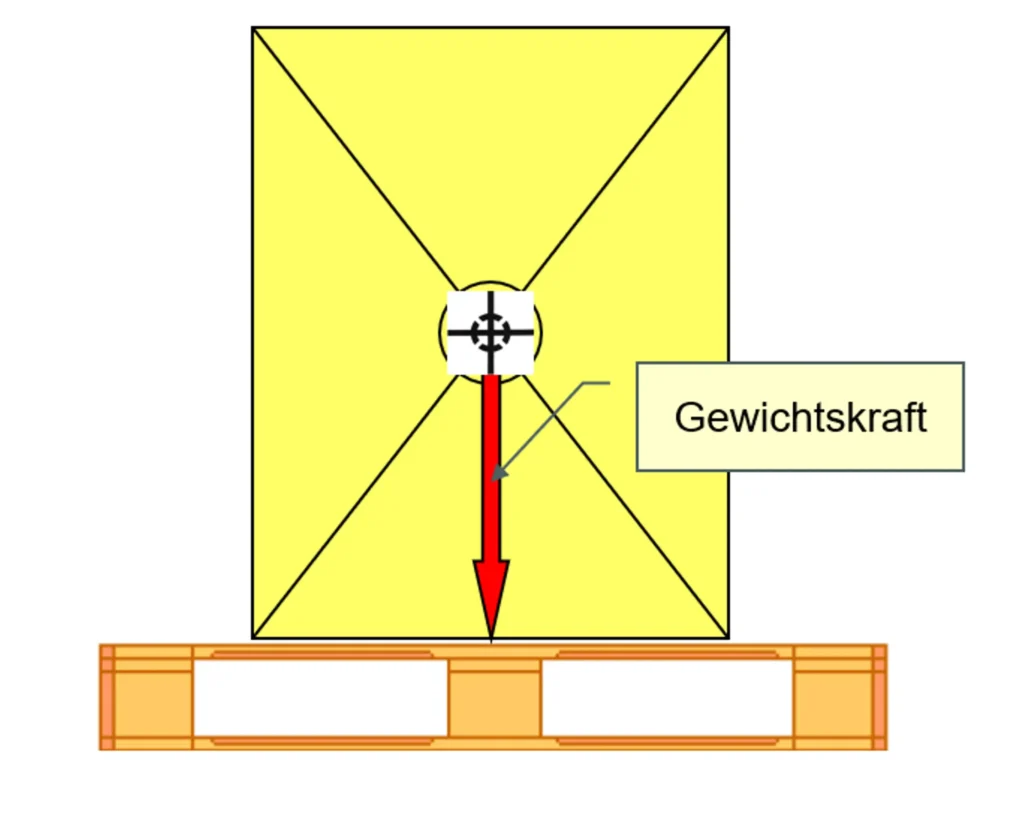
During the transportation phase, typical accelerations occur with every means of transport, which in many cases act parallel to the surface of the load carrier.
In other words, they act at right angles to the normal force/weight force. The example on the right assumes the braking deceleration of the truck with 0.8g.
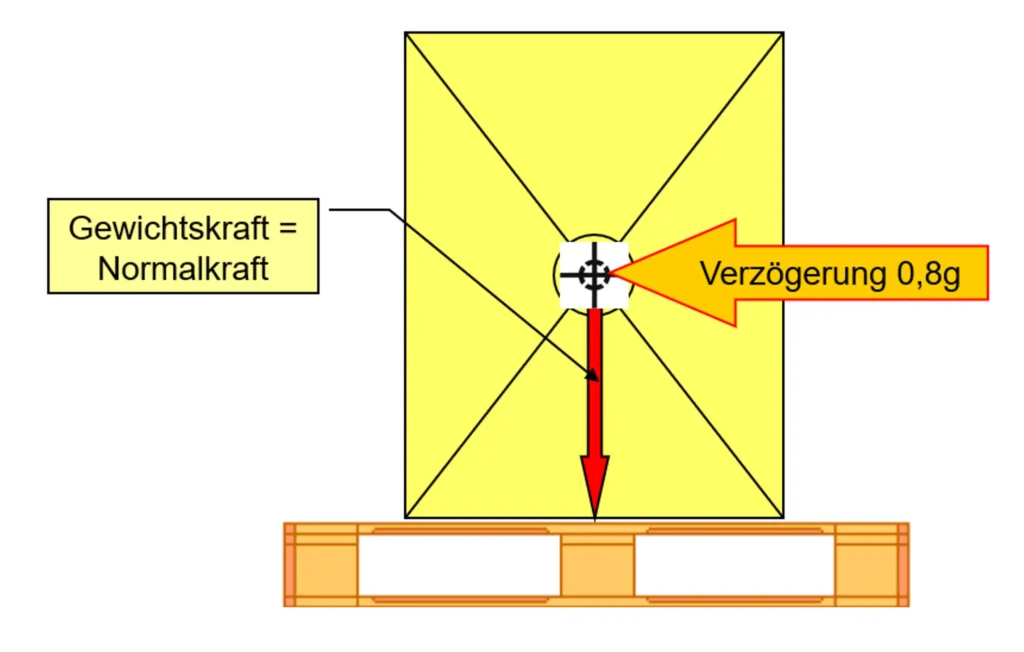
The above loading unit is idealized and only applies if the load consists of one piece.
However, most loading units consist of several cartons, barrels, canisters, bags, trays, etc. Each part has its own center of gravity and both the normal force and the accelerations act on each individual package.
Depending on the frictional forces around each package, each will also move individually.
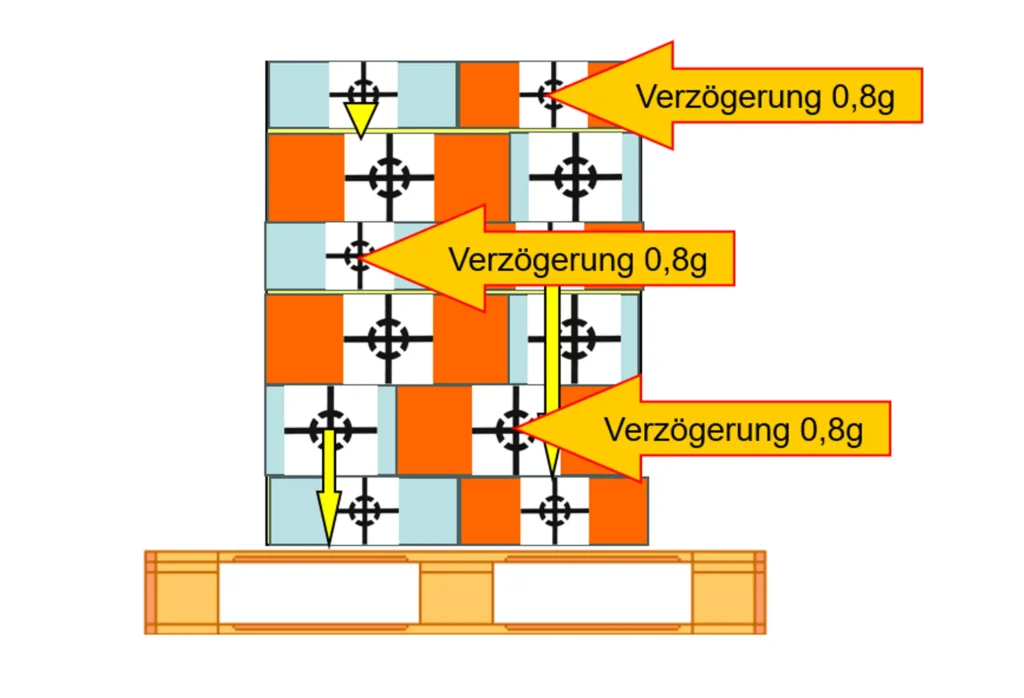
The aim of all load unit securing measures must therefore be to form a unit with a single overall center of gravity from a wide variety of packages so that it behaves as one piece, including the load carrier.
The means and methods by which this can be achieved is a large playing field. If the adjacent graphic suggests the wrapping film, this is not intentional.
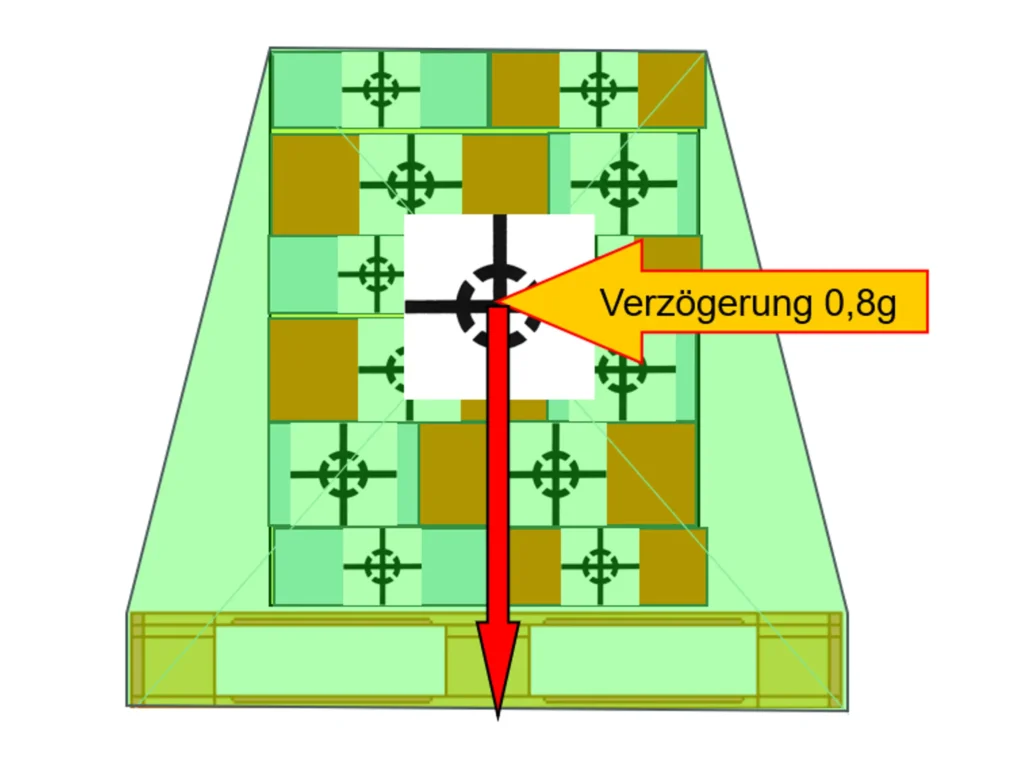
In order to test the stability of a load unit, the force acting on the packages due to a delay must be known.
It can be determined by driving tests or test sledges or by means of a tilt test.
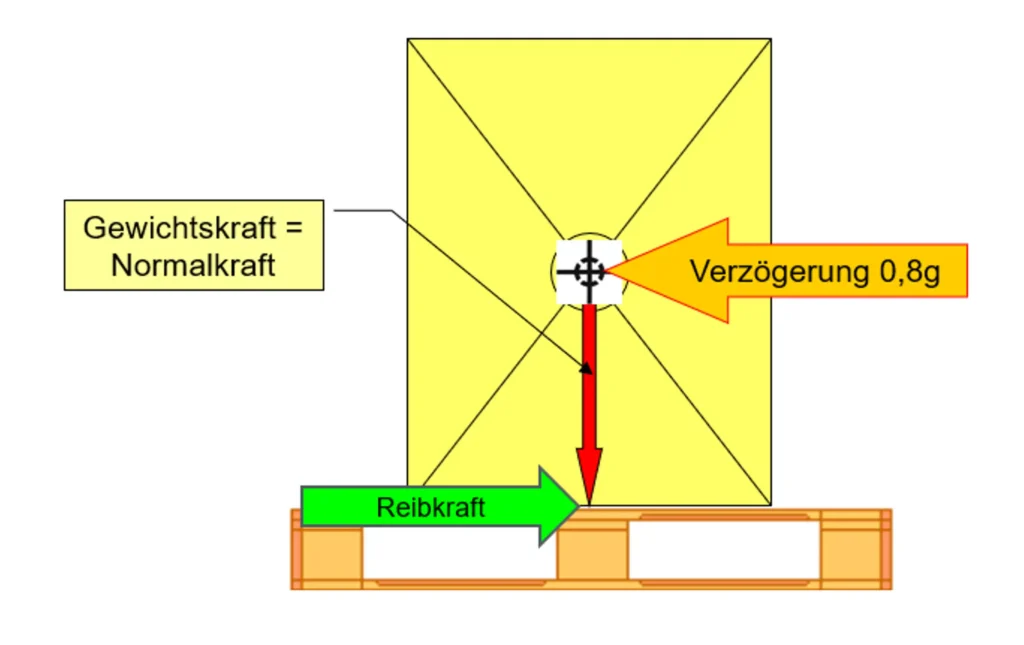
Lifting the pallet on one side with the forklift results in a division of forces.
– the normal force, perpendicular to the pallet surface
– the downhill force, parallel to the pallet surface
The frictional force counteracts the downhill force. It changes depending on the normal force.
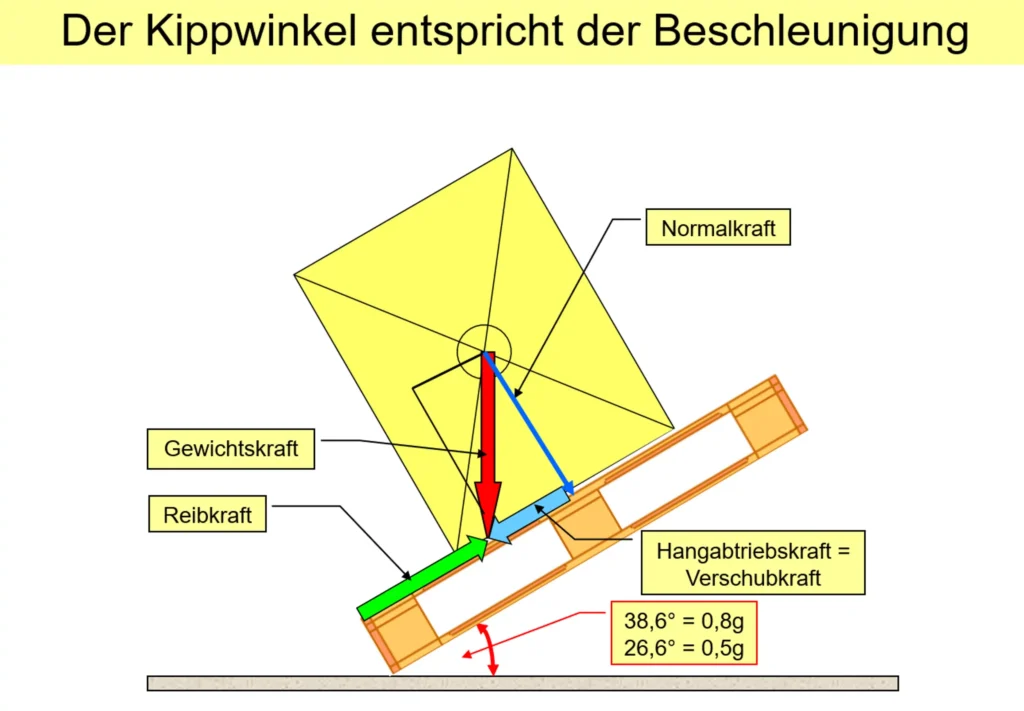
The test arrangement must be carried out in such a way that the zero point of the protractor is always identical to the tipping point of the pallet.
The example shows a tipping angle of 30°. It is assumed that the load unit itself is stable and that the packages on the load carrier have not changed their position.
The acceleration or downhill force can now be calculated using the tangent function with the tilt angle.
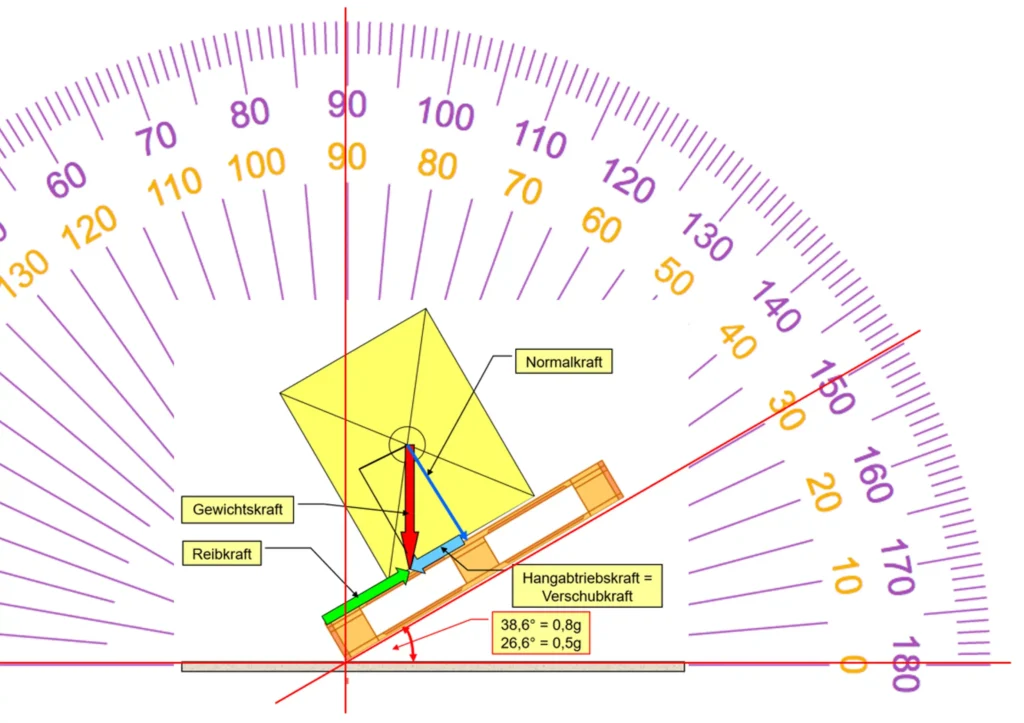
In principle, it would also be possible to place a protractor on the loading unit. However, it must then be taken into account that it can no longer be read correctly because the pallet changes its shape.
In order to obtain usable values, each test should be repeated several times under the same conditions.
The advantage of the tilt angle method is that the effect of each measure can be evaluated by changing the tilt angle. If the tipping angle increases, the measure is positive; if it decreases, it is negative. Experience shows that the targeted tipping angle is often not achieved because the load unit disintegrates.
Example: A load unit consists of buckets stacked in columns and is only secured with wrapping film. When the pallet is lifted, the bucket columns start to tip individually because the angled film cannot prevent this. This changes the overall center of gravity and the distance to the tipping edge of the pallet becomes shorter, causing it to tip over. The aim of the following measures must therefore be to prevent the individual bucket columns from tipping.
I will describe all the things that can happen in the following blog post, which deals with practical application tips.
Stay tuned.
Yours, Sigurd Ehringer
Previous article >>
Episode 54: Who is responsible in companies – technical measures

Thomas Bauer
✔ Marketing | Web | CI
Rothschenk assortment
Our customer center has only one goal: to turn your problems into solutions. Whether standard stowage cushions, bestsellers or load securing personally tailored to your needs -. we accompany you consistently from A as in field service to Z as in certification. That is our promise to you, as a leader in our industry.
We attach great importance to professional cargo securing. That is why we have our own production, which ensures reliable operation through modern manufacturing technologies and strict quality control. Thus, we offer our customers a comprehensive and high-quality range of services in the field of transport logistics.
DIN ISO 9001:2015, EMAS and Ecovadis are not foreign words to you? Then it's time to work with the best.
You don't take any risks with us - we have been awarded the Platinum Medal on the EcoVadis sustainability rating platform.
As a load securement company, we are proud to have several certifications that validate our sustainability efforts and our commitment to environmental protection and social responsibility. For you as a purchaser, this means that we demand and promote the implementation of high environmental and social standards both within the company and along the supply chain.
You are currently viewing a placeholder content from Google Maps. To access the actual content, click the button below. Please note that doing so will share data with third-party providers.
More Information